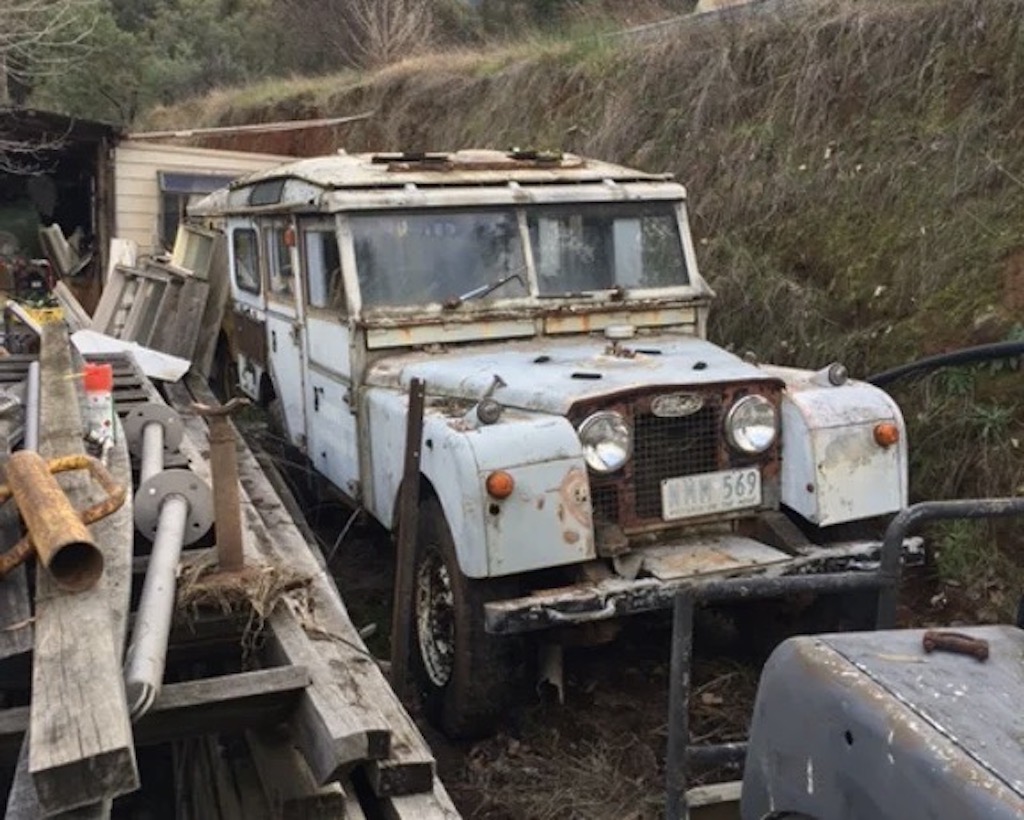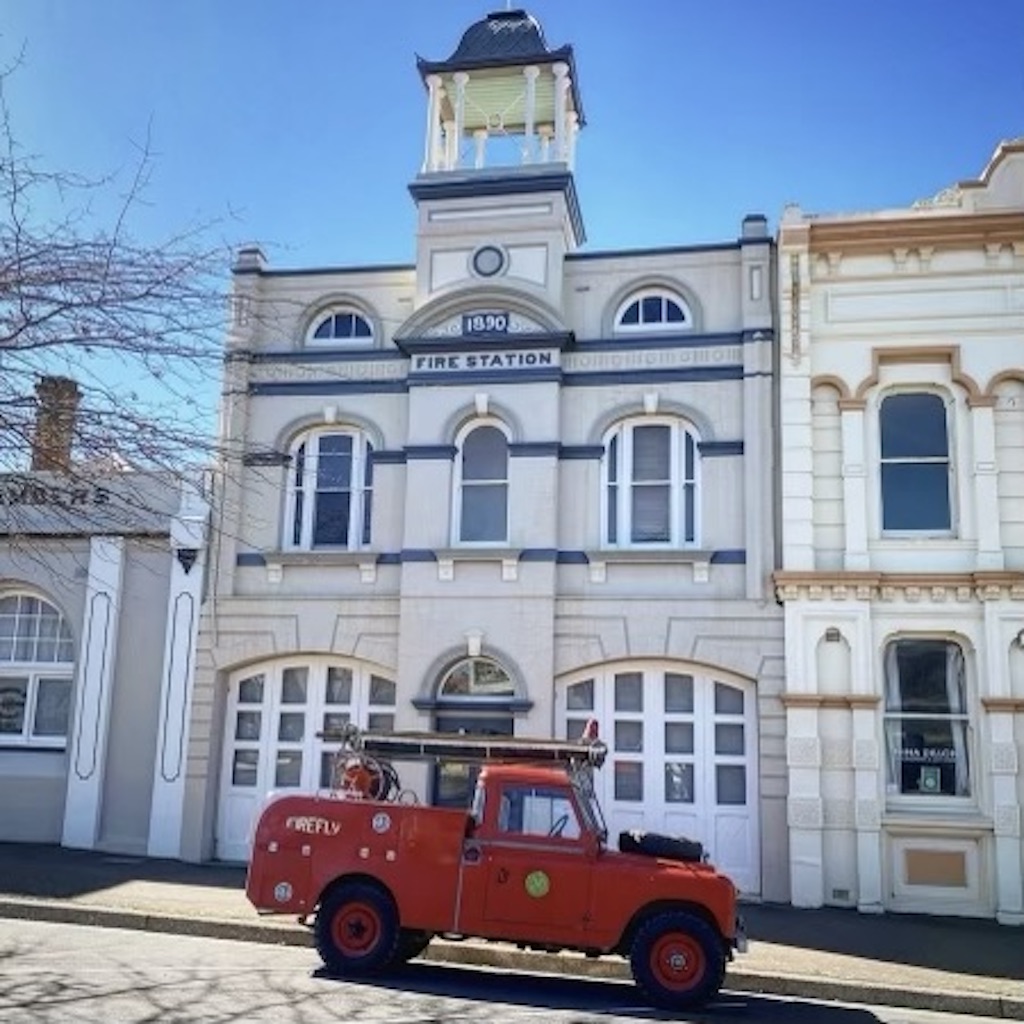
Land Rover specialist David D’Arcy with his 1953 model bought from an elderly widow. It had been her late husband’s pride and joy. It has a Queen’s head badge on the grille in recognition of being made in the year of her coronation. Photo: John Thistleton.
Christened ‘Mzuri’ (‘very good’ in Swahili), the old Land Rover had crossed the Sahara Desert, was lost for decades, languished on a junk heap until one Saturday night when the phone rang at David and Janelle D’Arcy’s home in Goulburn.
The caller from Mount Beauty in Victoria had no idea of the 1957 model’s history. But he knew David was a passionate Land Rover collector and told him the old car may once have been in a movie in the desert.
“We trekked off down there and there was a tonne of timber we had to move right by the side of it, chickens nesting in it and it did have rust,” David recalls. “We said, ‘We will buy it’. It was too rare to leave behind. Right at the very end he gave me a number plate: VAC-433,” he said.
That night, having unloaded the rusting car, David began googling station wagons in the desert. As soon as he typed in VAC-433, he discovered people had been looking for that car for 20 to 30 years.
A previous owner and famous photographer George Rodger who founded African Photos had travelled in it across the Sahara Desert in 1958 with his wife Jinx.
“An article in National Geographic, ‘Sand in My Eyes’, tracks that journey,” David said. “You read those stories in magazines, it gives you goosebumps to think you’ve got that car.” George Rodger has since died, but David and his wife Janelle returned to the United Kingdom and confirmed its origins with Jinx.
From South Hampton, David came to Goulburn in 2000 via Sydney, first as a backpacker on the Willing Workers on Organic Farms program, where he met Janelle. Already hooked on Land Rovers, he trekked around Australia with Janelle before they returned to Goulburn where the builder by trade began working. Often, on the way home he would come across an abandoned old Land Rover left in a paddock which he would load onto his truck.
“They are a Meccano set the way they come apart, so very easy to work on,” he said. “Most parts are available. You don’t have to be a mechanic to do it.”

In a junk heap, the missing VAC-433 Land Rover that had enthusiasts searching for decades, until the owner called David D’Arcy. Extraordinarily, he was surprised when David bought the abandoned car. Photo: David D’Arcy.
He and Janelle have travelled widely collecting old models and wonderful stories to go with them, like ‘Toot’ from Bibbenluke, so named because of its high-pitched horn, and a 1949 model retrieved from a riverbed near Gunnedah and a Series 1 they drove to Dubbo for, which belonged to Sunny, a returned serviceman who had turned 96 and turned to his son when the D’Arcys arrived to say: “Told you they would want it.”
They have found plenty of collectable models around Cooma which is unsurprising given 1500 Land Rovers came out from England for the construction of the Snowy Mountains Hydro-electric Scheme.
David has 56 Land Rovers in his collection, all with their own stories of the cars that never knew when to quit.
David’s building business has since given way to “Land Rover Heaven”, a specialist service for people wanting to get started restoring the durable, English-made workhorse.
“A lot of people want to get back to a car their dad had, they want to have those same memories with their children,” he said. The most sought after are the original 1948 models. Only 1500 were made worldwide.
The Queen and Prince Philip’s affinity for Land Rovers riveted David to Netflix’s The Crown during which he noted the changing times marked not by prime ministers, but the Series 1 Land Rovers through to Defender models.
He never has trouble finding buyers. “I have shipped 100 cars overseas, 80-odd back to the United Kingdom,” he said. “Some have even gone back to Land Rover and gone through the ‘reborn’ process,” he said, referring to Land Rover’s brand-building exercise with the 1985 model. They bought 85 Land Rovers back and fully refurbished them to brand new condition before reselling them.

This 1962 ‘Firefly’ was first used in Jindabyne on the Snowy Mountains hydro-electricity project. It is driven sparingly these days and remains in original condition, including the paintwork. Photo: David D’Arcy.
“Buying cars from Australia, they are in much better condition than they are in the UK; because they salt the road over in the UK, the chassis and firewalls just disintegrate,” David said. “I have cars up on the rack from 1950 with immaculate chassis and firewalls.
“If you break down on the side of the road in a Land Rover, another Land Rover owner won’t drive past you, they will always pull over. It’s an unwritten rule,” he said, having met an extraordinary number of their owners.








